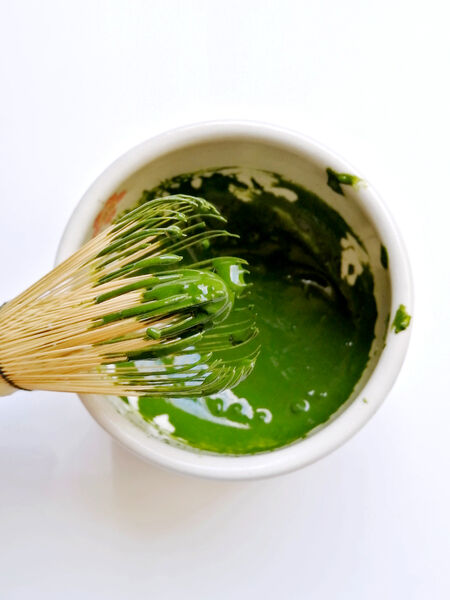Beginner's Guide to Koicha: Thick Matcha


Did you know that there are two ways in which you can prepare Matcha? The Matcha you are probably familiar with is usucha (thin tea). Usucha uses around 60-80ml of water (at 90° C) and 2g of matcha, which is whisked with a chasen (bamboo matcha whisk) to produce a light green froth of small bubbles. Though not all matchas are created equal and there are different qualities to each which will result in some producing more bubbles/froth than others, so the amount of froth is not indicative of the quality of the Matcha or the skill of the person preparing the tea.
Preparation
Koicha (thick tea) on the other hand is not enjoyed by nearly as many people as usucha due to most people finding it to be too thick and too strong. This method of preparation uses double the amount of matcha at 4g and much less water (around 30-40ml). Koicha is, however, not whisked like usucha and instead is kneaded. You still use a chasen but instead of whisking to produce bubbles, you use much gentler strokes that will combine the matcha and the water together without causing bubbles.
Really when it comes to koicha, I suppose you could say that it is to Matcha what gong fu style brewing is to true teas. It allows you to experience the Matcha in a much more concentrated way and you are able to taste all of the matcha’s best qualities in each and every sip. Many believe that koicha is a true way to take in all the qualities of the Matcha at its fullest, which is why only the highest quality matchas should be used to make it.
Consistency
The consistency of koicha is quite thick and has a syrupy consistency to it. It’s dark in color due to how much Matcha is used and often has a glossy sheen to it. I have always loved Matcha and drink it daily, but it was years after I started drinking it before I tried preparing and drinking koicha. It’s definitely a unique experience but I recommend every tea lover try it at least once.
Flavor Profile
The flavor profile is rich with strong umami notes, sweetness and much less bitterness. Before trying it I definitely expected it to be bitter from how it looks but that wasn’t the case at all, in fact it was much less bitter than other Matcha I have had and prepared as usucha. It is quite an intense experience but still a very pleasant one and one I do often return to now because I enjoyed it so much the first time I prepared and tried it. I would recommend making sure you have some sort of food while drinking koicha, preferably something sweet like wagashi as it helps to balance out the overall flavor of the tea.
More about Matcha
As I have been learning more, not only about matcha but also Japan itself, I recently learned that the best Matchas for koicha carries the character mukashi (昔) and the best Matcha for usucha carries the shiro (白) character. Before this year I had no idea that there were certain types of Matcha that were best for koicha or usucha but I’m really glad I have learnt about it and could pass the information on to you all through this post, and I really hope it enables anyone reading this to have better tea experiences.
Other Uses
Outside of simply drinking koicha there are a lot of different ways you can use it because of how concentrated it is, it can be added to lots of different foods. In fact, it’s not uncommon to see koicha top desserts like sweet mochi and sweet red beans, but my favorite way to use it is to make koicha affogato, a simple dessert that only requires two things. You need your favourite ice cream and some koicha. All you have to do is place your favourite ice cream into a bowl, prepare your koicha like you would if you were going to drink it and pour it over the ice cream. It’s such a simple dessert but it's phenomenal and will no doubt be a quick favorite if you have a sweet tooth and enjoy the way that Matcha tastes. You can really use any flavor ice cream you want for this but I find that ones that work best are things like clotted cream, vanilla or white chocolate ice creams, they provide their own flavors but let the Matcha take the spotlight without overpowering it. They also tend to be a little creamier and that works so well with the natural creaminess of Matcha and the thickness of the koicha. After pouring the koicha over the ice cream, I recommend stirring it through as you’ll get much more balanced mouthfuls this way, but you can of course enjoy it without doing so.
Another great way to use koicha is that prepare a small amount and use it almost as a form of edible paint to add art to the top matcha latte, and I suppose you needn’t stop at just lattes it would be great to decorate desserts as well and add an extra element of aesthetics to them. Matcha is incredibly versatile outside of koicha but when you add koicha into the mix as well the options become endless.
I hope you enjoy this new way of preparing Matcha, no matter how you decide to enjoy it!
